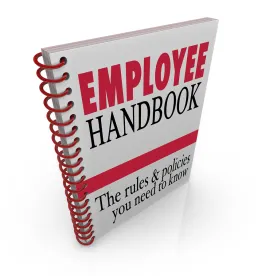Employee handbooks. Say those words around any seasoned HR professional and watch them cringe. Yes, handbooks are often relegated to the “I’ll get to that when I have time” list, which is understandable in today’s busy corporate environment where tasks critical to the business receive priority status. But handbooks are important and deserve inclusion on the list of asset protection initiatives for the new year. Why, you ask? Because a poorly drafted handbook exposes a business to unnecessary risk of liability. Liability can range from the more obvious—failure to make appropriate at-will employment and no contract disclaimers may bind the company to statements in the handbook where flexibility is needed—to the less obvious—failure to address relevant state and local laws and the affirmative obligations placed on employers in those laws can foster a culture of noncompliance and possible class actions. And putting aside the liability issues for a moment, a properly drafted employee handbook can be used as a guidebook for managers, a go-to resource for a company’s workforce, and an effective tool for communicating performance and conduct expectations.
While the benefits derived from those goals may not be as easily measured on your corporate balance sheet, your management will thank you in the long run. So, whether your primary goal is to lower risk exposure or instead to protect your largest asset (your workforce), the time and resources necessary to “update” your employee handbook will not be wasted.
Okay, okay, so I get it, handbooks are important. But the title of this blog suggested that you were going to tell us what’s new in the realm of employee handbooks and why it matters. Fair point. Much like politics, when it comes to employee handbooks, the saying “everything is local” also applies (well, maybe not “everything”, but “a whole lot is local” is just not as catchy). That wasn’t always the case, but in the past few years (and the trend is likely to continue), there has been so much action at the state and city/county level that employers who use a one-size-fits-all handbook for their business do so at their peril. Yes, that’s right. States and localities are where the action is—both with respect to legislative action and enforcement.
Thus, it’s time to take the employee handbook off the “I’ll get to that when I have time” list and place it on the critical “asset protection” list. In an upcoming six-part series, we will highlight some of the key issues to consider when evaluating whether it’s time to update your employee handbook.
#1 – Anti-harassment law and training: If you’ve been paying attention to what has been happening over the past 18 months, then it shouldn’t be a surprise to you that a properly drafted anti-harassment policy is essential, and training on that policy is just as essential. Indeed, New York, California, Massachusetts, and several other states/cities now mandate what must be included in an employer’s sexual harassment policy (e.g., due process rights for both the alleged victim of harassment and the alleged harasser) and in the training on that policy. We will take a closer look at those policy and training requirements in Part 1 of our series.
#2 – Paid Sick Leave: If you’re wondering what all the fuss is about, state and local governments have been busy over the past several years enacting relatively generous paid sick leave laws that often apply to all employees. Thus, while paid sick leave may not be mandated by federal law, if you’re an employer operating in California, Washington, New Jersey, Connecticut, Arizona, Maryland, Oregon, Rhode Island, and other localities (e.g., Chicago, NYC, San Francisco, Philadelphia), and soon to be Michigan, you really need to take a close look at your paid sick leave policy to ensure it is compliant. We will take a closer look at those paid sick leave laws in Part 2 of our series.
#3 – Workplace Accommodations – Beyond the ADA: Most employers understand that federal law, i.e., the Americans With Disabilities Act, requires providing reasonable accommodations to qualified individuals with a disability. But several states and localities provide even more generous rights to employees who have a disability, or employees who need an accommodation for religious observance, pregnancy or related medical conditions, or because they may be a victim of domestic or sexual violence. For example, NYC now requires employers to engage in a cooperative dialogue with employees who request an accommodation for any of these reasons, and the results of that process must be documented. Similarly, California, Illinois, and NYC have specific requirements for what must be included in a lactation accommodation policy. We will take a closer look at workplace accommodations in Part 3 of our series.
#4 – Wage and Hour/Compensation Policies: Certainly, employers must be mindful of any state laws mandating rest periods and/or time requirements for a meal period when they are drafting an employee handbook. But other less obvious wage and hour laws must also be considered. For example, as employers try to more accurately track their employees work hours, such things as time clocks that require a fingerprint to log in have gotten some into hot water in states like Illinois, Texas, and New York that have laws restricting the collection of biometric data. And have you considered how your bonus policies may affect the regular rate of pay for your non-exempt employees? And how do you address overtime in your handbook? We will take a closer look at wage and hour and compensation policies in Part 4 of our series.
#5 – Leave Policies Beyond the FMLA: Hopefully, if you have at least 50 employees, then you know that you are a covered employer under the federal Family and Medical Leave Act. But is your FMLA policy compliant with federal regulations? And, even if it is, have you considered whether there are other state or local leave laws that provide similar or greater leave rights to your employees and whether those laws must be included in your employee handbook? For instance, New Jersey, Connecticut, Wisconsin, and California (just to name a few) have state-equivalent family and medical leave laws that provide additional leave rights to employees. And some states (e.g., Massachusetts, Minnesota, California) have parental leave laws. We will take a closer look at various state leave policies in Part 5 of our series.
#6 – Drug Testing and Privacy Laws: Marijuana is still a Schedule 1 drug under federal law, but is legal in some states (either for medicinal and/or recreational purposes). How do you address that conflict in your workplace drug testing policy? If you haven’t thought about it, you really should. And while you have heard of all those companies experiencing data breaches (and may have even received a notice that you were impacted by a breach), what does that have to do with employee handbooks? Well, some states, like Massachusetts and Maryland, have laws that address data privacy breaches. For instance, Maryland’s Personal Information Protection Act places certain restrictions on a business when it discovers a breach of its security system, and personal information now includes biometric data, such as fingerprints. We will take a closer look at drug testing and privacy laws in Part 6 of our series.
These issues and others will be addressed in upcoming blog posts. Stay tuned!




 />i
/>i

